Following is from PIB release http://pib.nic.in/release/release.asp?relid=53747.
|
Update on AIIMS-like institutions tenders/nits worth Rs. 1908 Cr for the main civil packages for six new AIIMS-like institutions invited
|
| |
17:38 IST |
Government of India has launched the Pradhan Mantri Swasthya Suraksha Yojana (PMSSY) with the objective of correcting regional imbalances in the availability of affordable/reliable tertiary healthcare services and also to augment facilities for quality medical education and research in the country. Under the Ist phase of this scheme, six new AIIMS-like institutions are being set up, one each in the States of Bihar (Patna), Chattisgarh (Raipur), Madhya Pradesh (Bhopal), Orissa (Bhubaneshwar), Rajasthan (Jodhpur) and Uttarakhand (Rishikesh) at an estimated cost of approximately Rs 820 Crores per institution. Each of these institution will have a 960 bedded hospital (500 beds for the medical college hospital; 300 beds for Specialty/Super Speciality departments; 100 beds for ICU/Accident and trauma. In addition 30 beds for Physical Medicine & Rehabilitation (PMR) and 30 beds for Ayush have been kept. This would be full fledged multi-disiciplinary healthcare institution offering facilities in 42 speciality/super-speciality disciplines. Medical College will have an annual intake of 100 UG intake besides imparting PG/doctoral courses in various disciplines. Nursing College will also have 100 UG intake and 25 PG intake annually.
The respective State Governments have provided 100 acre land free of cost. The Ministry of Health and Family Welfare, Govt. of India engaged eminent architectural firms to prepare the designs and drawings. The architectural/DPR Consultants were selected on global competitive basis. The Project Consultants have also been selected for each site on the basis of open competitive bids. Project Cell at the sites comprising engineering, finance and administrative set up has been constituted and posts are being filled up on deputation basis from other Central Govt./State Govt. organizations.
The construction work has been split into 7 different packages, depending on the functional /sequential requirement and core specialization needs. Tenders/NITs for the main civil packages viz. (i) Civil works for Medical College, Nursing College, AYUSH and Hostels, (Patna, Raipur, Bhopal); and (ii) Civil works for Hospitals – OPD Complex including all internal services and specialized works are being invited. The total cost of these two packages is between Rs.250 – 300 Crore for each site, totaling Rs. 1908 Cr. for all six sites.
The salient features of the tenders /NITs issued on 2nd Nov. are as follows:-
(i) All detailed engineering drawings have been prepared.
(ii) Environmental clearance has been obtained for 5 out of 6 sites and is being obtained for the remaining site (Bhopal).
(iii) Medical College Complex will be built in 15 months time.
(iv) The Hospital – OPD complex is to be built in 24 months.
(iv) Apart from ensuring timely payment, there are very strong incentive clause for early completion with a bonus of 1% of the tendered value per month computed on per day basis, subject to maximum of 5%.
(v) Like-wise there is a strong disincentive clause/penalty if the project is delayed.
Pre-bid Conference is scheduled for 16th November, 2009. Last date of receipt of bids would be 3 Dec 2009
************
October 30th, 2009
.jpg)
IIT Bhubaneswar has unveiled a new web page. It looks very good. Based on the information there it currently has 16 regular faculty in its five schools including the Director. They are:
- School of Basic Sciences
- Sujit Roy, Professor & Head, Chemistry, PhD, 1987, IIT Kanpur
- Srikanta Patra, Assistant Professor, Chemistry, PhD, 2005, IIT Bombay
- Sabyasachi Pani, Assistant Professor, Mathematics, PhD, 2004, IIT Kharagpur
- Rajan Jha, Assistant Professor, Physics, PhD, 2007, IIT Delhi
- Snehasis Chowdhuri, Assistant Professor, Chemistry, PhD, 2005, IIT Kanpur
- Akshay Kumar Ojha, Assistant Professor, Mathematics, PhD 1997, Utkal University
- School of Electrical Sciences
- Ganapati Panda, Professor & Head, PhD, 1982, IIT Kharagpur
- Prasant Sahu, Assistant Professor, PhD 2009, IIT Kharagpur
- Debalina Ghosh, Assistant Professor, PhD 2008, Syracuse University
- School of Infrastructure
- Sekhar Dutta, Professor & Head, PhD, 1982, IIT Kharagpur
- P. Dinakar, Assistant Professor, PhD, 2008, IIT Madras
- Puspendu Bhunia, Assistant Professor, PhD, 2008, IIT Kharagpur
- Sumanta Haldar, Assistant Professor, PhD, 2008, IISc Bangalore
- School of Mechanical Sciences
- Madhusudan Chakraborty, Director and Professor, PhD, 1978, IIT Kharagpur
- Swarup Mahapatra, Associate Professor & Head, PhD 2000, Jadavpur University
- Prasenjit Rath, Assistant Professor, PhD 2007, NTU Singapore
- Satyanarayan Panigrahi, Assistant Professor, PhD 2007, IISc Bangalore
- School of Social Sciences & Humanities
October 24th, 2009
Following is an excerpt from a report in Business Standard.
Hyderabad-based Institute of Chartered Financial Analysts of India (Icfai), which is aiming to set up a multi-disciplinary university in Orissa at an investment of Rs 150-200 crore, has identified 53 acres of land for the university.
The land has been identified close to Sum Hospital on the outskirts of the city. Out of the total land area of 53 acres, Icfai has got 11 acres of land registered for the university project.
… The university project in Orissa has been marred by delay as the Icfai Private University Bill is yet to be introduced in the state legislative assembly.
The Icfai Private University Bill would be introduced soon in the forthcoming session of the Orissa legislative assembly, claimed Noorus.
Icfai had earlier announced that its proposed university in Orissa would be functional eighteen months after the Icfai Private University Bill became an Act.
The Icfai University in Orissa would have no management quota, NRI quota or capitation fee. The university would have strength of about 1,500 students and offer courses in various disciplines like engineering, management, law, science and humanities.
Apart from Orissa, Icfai is also setting up universities in other states across the country. States like Uttaranchal, Tripura, Sikkim, Mizoram, Meghalaya, Nagaland and Jharkhand have passed the legislations facilitating the establishment of Icfai universities.
The proposed Icfai universities in Uttaranchal and Tripura have received the approval of the University Grants Commission (UGC) under Section 2 (f) of the UGC Act.
Other states like Chhattisgarh, Punjab, Himachal Pradesh and Rajasthan have already issued letters of intent to Icfai for setting up universities.
The Orissa government needs to be careful with respect to ICFAI. Earlier this year there have been controversies regarding its operation in Hyderbad and in Bangalore.
October 24th, 2009
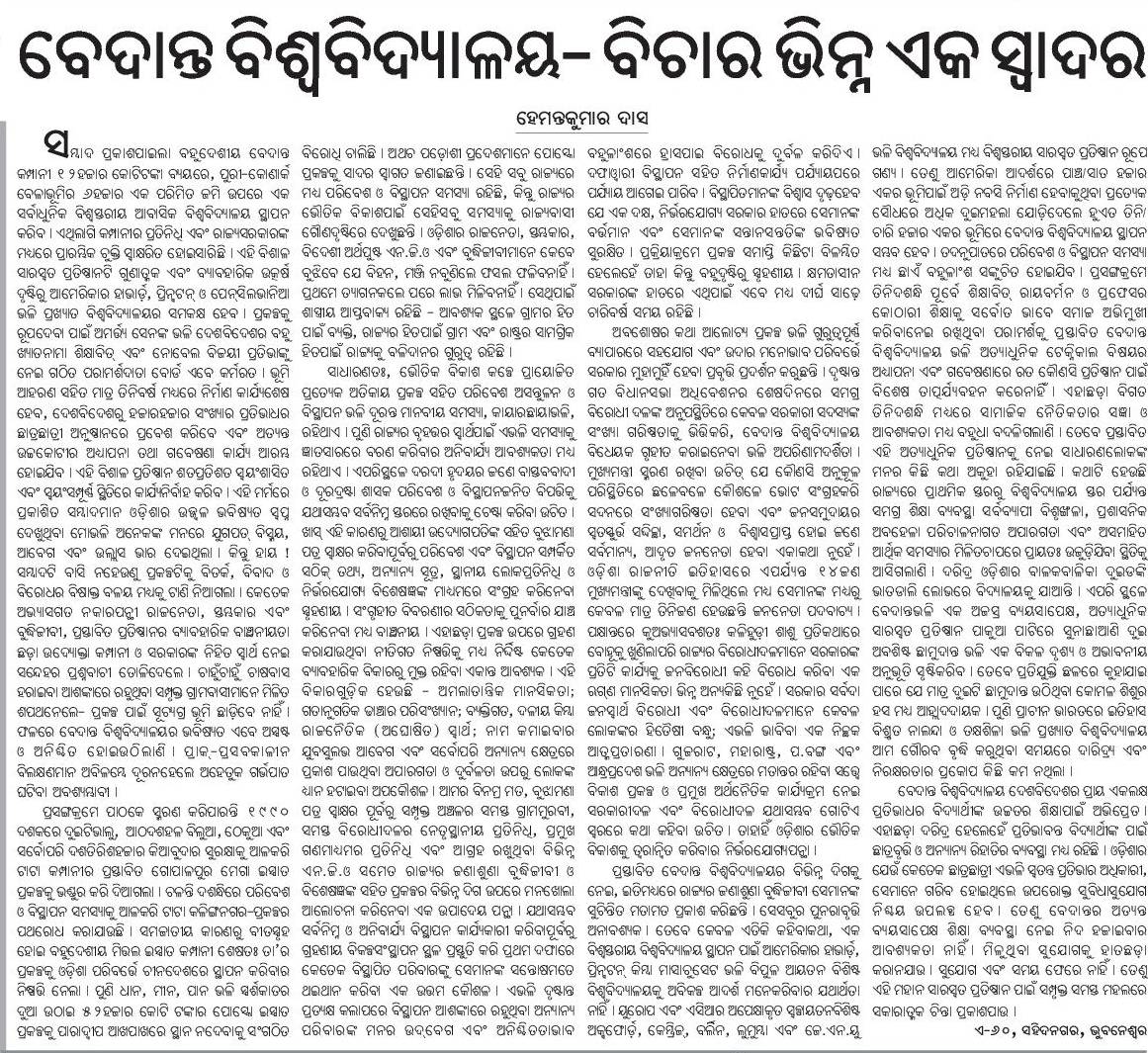
October 22nd, 2009
Following is from Dharitri.

October 21st, 2009
Although MOS from Orissa, Srikant Jena gets high marks for trying, but based on his past record (unsuccessful in getting Army to make a medical college in Balasore; no progress on a NIPER in Orissa) one has to wait for other indications before one can conclude that an IIPH (Indian Institute of Public Health) is being established in Orissa. But any way, here is the latest from Samaja.
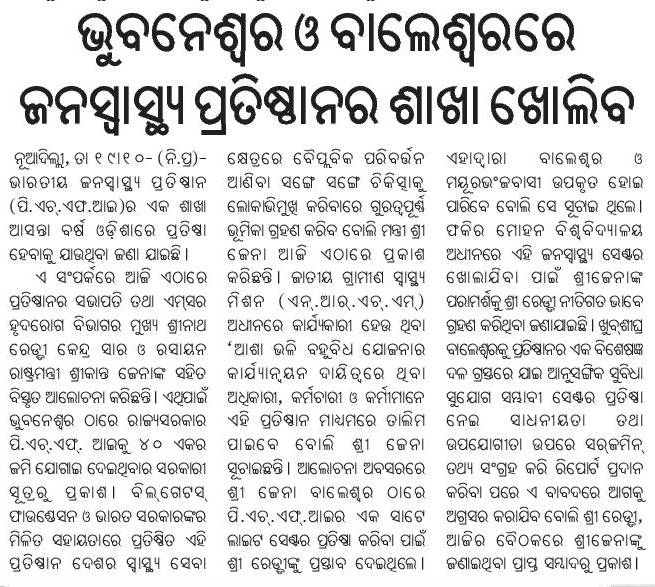
October 20th, 2009
This is mentioned in the scrolling headline of its web page at http://www.srisriuniversity.org/ver2/default.htm. About the courses that will be offered, following is from http://www.srisriuniversity.org/ver2/courses.htm.
Sri Sri University aims to become a centre of excellence matching international standards in education. This will be enabled by offering courses in various disciplines, organized into schools that will function as logical academic entities.
Keeping in mind, the growth of various economic sectors and their employment potential, the needs of the society and country at large and vision of His Holiness Sri Sri Ravishankar, an indicative list of schools proposed in multiple disciplines are:
- Management
- Engineering
- Medicine
- Law
- Government
- Education
- Mass Communication
- Agriculture
- Tourism
- Indology
- Advanced Research
To impart marketable skills in short duration and generate qualified employable individuals in a short span of time for our burgeoning economy, Certificate school will impart 6 month courses in various fields.
Proposed courses for first year
|
School
|
Name of the Course
|
Duration
|
|
Management
|
PGDM (Marketing)
PGDM (Finance)
PGDM (HR)
PGDM (Systems)
|
2 Years
|
|
Agriculture
|
AgriBusiness Management
|
2 years
|
|
Education
|
Bachelor in Education
Masters in Education
|
2 Years
2 Years+
|
|
Medicine
|
Research in Ayurveda
Osteopathy
|
4 Years
2 Years
|
Certificate courses of 6 month duration will be offered in the manufacturing stream e.g. Welding , Electrical etc. as well as in IT stream e.g. Computer Hardware, Web Designing and Graphics etc.
In regards to its short term and long term mission, following is from http://www.srisriuniversity.org/ver2/mission.htm.
Sri Sri University aims to create centers of excellence for providing knowledge, education, training, and research facilities of high order in the field of arts, commerce, science, technology, media, healthcare, business, and other related higher education. The focus of the university is to function in Orissa, India and then the world as a learning resource centre which provides opportunity to learn, teach, research with relevance to the needs of the economy at a national and international level. It also aspires to provide arrangement for national and international participation in the field of higher and professional education including technical education with close associations with the relevant industry. The programs that are value based with inspiration from His Holiness Sri Sri Ravi Shankar in which the aspiration of India and the world in terms of educational standards are met.
The endeavour is to have,
-
A core campus comprising academic and non-academic buildings to cater to the needs of 15,000 students, 1,500 faculty and matching number of non-teaching staff with adequate infrastructure, in terms of physical facilities, excellent faculty as well as the right environment that would attract the best talent.
-
Courses that are in demand such that the students get ready employment. Basic science, humanities, engineering, medicine, pharmacy, business management, law, bio-science, art, culture and vedic studies, ayurveda is on the list.
-
To Institute 44 courses in next 5 years across disciplines.
-
To have 8 fully functional and completely equipped departments in next 10 years.
-
To initially admit approximately 350 students and approximately 3000 students by its fifth year
-
To employ 35 faculty members in its first year and 145 by its 5th year.
-
To set-up a separate world-class Medical College within the campus to produce qualified doctors with a deeper sense of commitment and responsibility towards this noble service. The college shall also have an adjacent Super-Speciality Hospital with the latest state-of-the-art facilities and equipments to facilitate total practical experience to the students to complement the excellent theoretical education, and also to provide comprehensive treatment facilities for the needy from far and wide.
Some more detail about the teaching hospital time line is at
http://aolhet.com/en/node/2. We present it below.
Sri Sri University Teaching Hospital
The goal of the Sri Sri University Teaching Hospital is to provide primary, preventive and educational healthcare. The Teaching Hospital will offer state-of-the-art, affordable medical care to communities in underserved areas by using an integrated approach that combines traditional health care and modern technology.
In the period between 2011 and 2016 the Art of Living Health and Education Trust aims to:
• Design and construct the Sri Sri University Teaching Hospital with specialized facilities on campus;
• Build 25 primary care satellite clinics in locations determined by a feasibility study;
• Offer telemedicine services in primary care clinics with the capability to transfer patients with specialized medical needs to appropriately staffed and equipped clinics;
• Emphasize community-driven development through the International Association for Human Values’ 5H program [Health,Hygiene, Homes, Harmony in Diversity, Human Values]; and
• Develop a replication strategy using the design, construction, and operations of the Sri Sri University Teaching Hospital as a prototype, in collaboration with other NGOs and charitable organizations, to extend His Holiness Sri Sri Ravi Shankar’s vision of affordable primary, preventive and educational healthcare to other parts of the world.
October 11th, 2009
The following list is based on the information in the page http://sctevtorissa.in/collegedetail.aspx?Cid=2 extracted today.
Bhubaneswar-Cuttack-Khurda-Puri area:
- BOSE, Cuttack
- DRIEMS, Tangi
- ITT, Choudwar
- Dhabaleswar Institute of Polytechnic, Athagarh
- Gurukrupa Technical School, Narsinghpur, Cuttack
- Kalinga Polytechnic, Bhubaneswar
- Nilachal Polytechnic, Bhubaneswar
- Women’s Polytechnic, Bhubaneswar
- Krupajal Engineering School, Bhubaneswar
- CV Raman Polytechnic, Bhubaneswar
- Koustav School of Engineering, Bhubaneswar
- CIPET, Bhubaneswar
- Bhubaneswar Polytechnic, Bhubaneswar
- Nalanda Institute of Technology, Bhubaneswar
- Suddhananda Residential Polytechnic, Phulnakhara
- Ganesh Institute of Engineering & Technology, Bhubaneswar
- Swami Vivekenanda School of Engineering & Technology, Bhubaneswar
- ARYAN INSTITUTE OF ENGINEERING TECH, Bhubaneswar
- Ideal School of Engineering, Retang, Khurdha
- Puri Engineering School, Puri
Berhampur area:
- SMIT, Ankuspur
- UCPES, Berhampur
- Women’s Polytechnic, Berhampur
- BSET, Berhampur
- Gandhi School of Engineering, Berhampur
- Aumasi Institute of Technical Education, Berhampur
- Kalam Institute of Technology, Berhampur
Koraput-Jeypore area:
- IEM, Jeypore
- Hi-Tech Institute of Information Technology, Jeypore
- Jeypore School of Engineering & Technology, Jeypore
- Siddhartha Institute of Engineering & Technology, Koraput
- SCSITM, Semiliguda
Rourkela area:
- Purusottam School of Engineering & Technology, Rourkela
- RIT, Kalunga
- SKDAV, Rourkela
- UGIE, Rourkela
Angul-Talcher-Dhenkanal area:
- IGIT, Saranga
- Pabitra Mohan Institute of Technology, Talcher
- KIMET, Chhendipada, Angul
- Women’s Polytechnic, Dhenkanal
- Orissa Institute of Engineering & technology, Dhenkanal
- Pathani Samanata Institute of Engineering & Technology, Dhenkanal
Jharsuguda-Sambalpur-Baragarh-Sundergarh area:
- JES, Jharsuguda
- BDSE, Brajarajnagar
- SES, Sundergarh
- PKAIET, Baragarh
Rayagada area:
- MITS INSTITUTE OF POLYTECHNIC, RAYAGADA
- UGMIT, Rayagada
Others:
- BSET, Barapada (Bhadrakh)
- BSE, Balasore
- MSE, Baripada
- SITE, Bolangir
- Kalahandi School of Engineering & Technology, Bhawanipatana (Kalahandi)
- Biju Patnaik Institute of Technology, Phulbani (Kandhamala)
- OSME, Keonjhar
- Sri Polytechnic, Komonda, Nayagarh
- Mahamaya Institute of Medical & Technology Science, Nuapada
October 11th, 2009
Following is from Samaja.
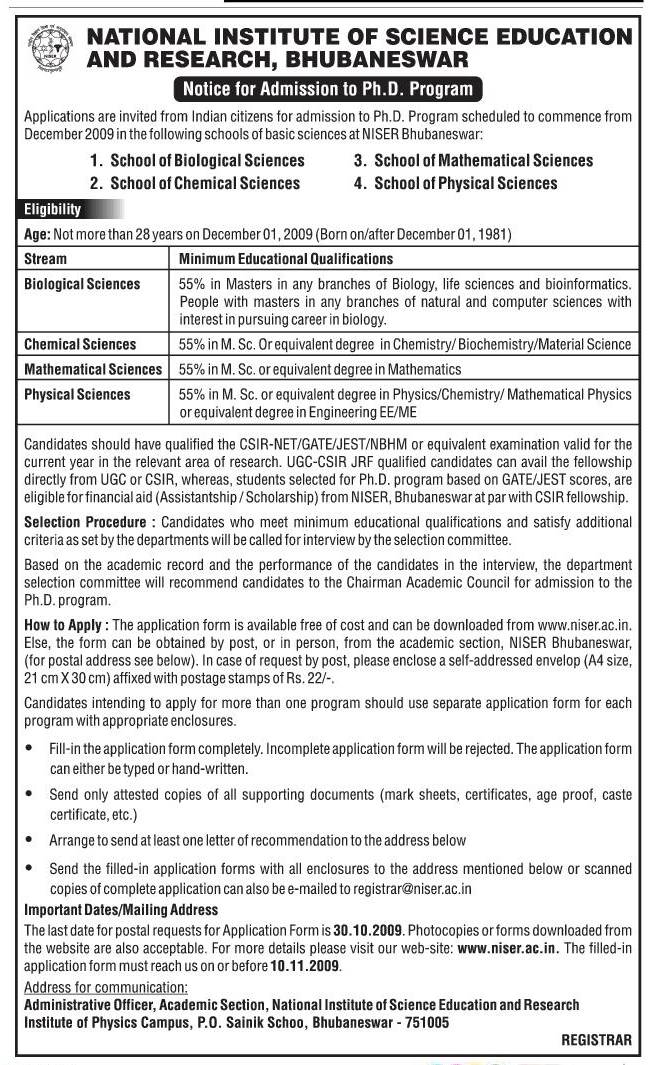
October 8th, 2009
The following appeared in Samaja. I wonder if there is some imminent move by Vedanta University project.
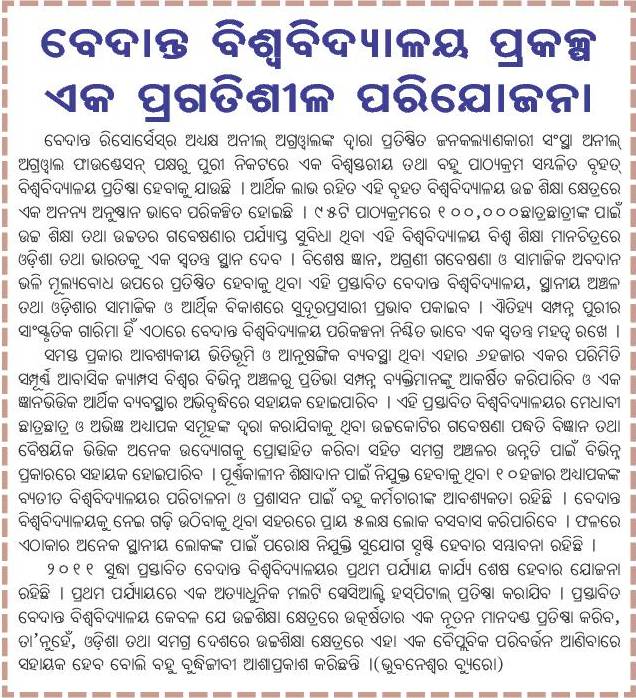
I am actually not sure if the above is an article or an ad. I think its an ad.

October 4th, 2009
Update: The following was written before I saw this article in Pioneer.
Tathya.in has a report on Dr. Digamabara Patra’s request for a national or central university in Bhawanipatna, Kalahandi. A lot of the arguments made there make sense. Many of the recent central universities have been established in rural and semi-urban areas and indeed there is no reason why one should not be established in Bhawanipatna; especially since its citizens have been asking for one for more than 2 decades.
However, as mentioned in the article https://www.orissalinks.com/archives/3229 adequate infrastructure seems to have been an important factor in determining the locations of the new IITs, IIMs and National universities.
For Orissa to have them in locations ouside of Bhubaneswar, there are two ways to go about it.
- Argue that adequate infrastructure should not be a requirement or they will automatically come once the institutions are established.
- Develop areas outside Bhubaneswar to have adequate infrastructure.
To me pursuing (2) has a higher chance of success than pursuing (1) and even if (1) is successful the institutes/universities in locations without appropriate infrastructure will struggle until the infrastructure eventually catches up which may take a long time if just left to fate. (Such a struggle may result in Orissa not being given in appropriate numbers additional central/national institutes.)
[In India people sometime point out that IIT Kharagpur was established in a rural location. First, Kharagpur is only 116 kms from Howrah. Second it has been a major railway junction for a long time. Third it was the first IIT and for a long time only one of 5 IITs. Similarly Roorkee was the oldest engineering college and is close to Haridwar and Dehradun. There are a few top universities and institutions in the US that are in rural areas, but these are exceptions, and the infrastructure in rural areas of US are quite good compared to rural areas of India. For example, Univ of Illinois at Urbana Champaign and Penn State University in State College, PA are often mentioned in that context. But both do have small airports with commercial flights.]
Before we suggest what needs to be done regarding developing areas outside Bhubaneswar to have adequate infrastructure, let us address what may be coming in the future and why Orissa needs to do this urgently so as to not risk missing future allocations of national institutions.
The National Knowledge Commission (NKC) in its December 2006 note on higher education has explicitly suggested 50 national universities in India. It says:
We recommend the creation of up to 50 National Universities that can provide education of the highest standard. As exemplars for the rest of the nation, these universities shall train students in a variety of disciplines, including humanities, social sciences, basic sciences, commerce and professional subjects, at both the undergraduate and post-graduate levels. The number 50 is a long term objective. In the short run, it is important to begin with at least 10 such universities in the next 3 years. It is worth noting that the National Universities need not all be new universities. Some of the existing universities could also be converted into National Universities, on the basis of rigorous selection criteria, to act as exemplars. We recognise that there could be a human resource constraint if faculty members are not available in adequate numbers to establish these universities.
The current government has implemented most of the recommendations of the NKC and exceeded some of them. For example, instead of the recommendation of 10 national universities in the three years following the report (2007-2010), establishment of 14 have been announced. Moreover, the higher education budget has been increasing drastically from one five year plan to the next. The 12th five year plan starts in 2012 and it is expected that it will take up on the long range objectives of the knowledge commission. In other words there could and should be more central and national universities in the 12th plan.
[My impression is that how soon additional national universities are established will depend on the success of the first 14. It seems to me that the locations of the first 14 have been greatly influenced by the consideration of, where in each of the states selecetd, does it have the best chance to succeed.]
Unless Orissa is prepared for it, Orissa may lose out pieces of those plans on lack of infrastructure grounds. Other states with multiple locations with adequate infrastructure will get preference and Orissa may lose out.
However, 2012 is still 3 years away and if adequate steps are taken very soon, Orissa should be able to get its fair share.
The pity is there are areas in Orissa which are on the verge of having the necessary infrastructure, mostly through private investment, but because of non-constructive opposition, blind suspicion towards industrialization and the relcucatnce of many to speak out in favour of development and industrialization, the development and associated infrastructure building has been greatly hampered. The governments (state and center) are also at fault for their sluggishness on some aspects.
Following are some suggestions:
- The state government should push for the completion of the airport in Jharsuguda within a year.
- It should make an all-out effort to have commercial flights operating out of the existing airport in Rourkela. In general, the people of the area need to recognize the existing infrastructure and potential of Rourkela and take advantage of it. Currently, as a friend of mine would say, Rourkela is an orphan. This is a pity. It is a big asset to Orissa, especially to the western parts of Orissa; but is severely underutilized and undermined.
- Coming back to Jharsuguda, the people there should follow a smarter approach in not opposing and rather facilitating industries coming up there, and at the same time being vigilant about environmental and land acquisition related R & R issues. If these industries and investment are allowed to materialize there soon, then Sambalpur-Jharsuguda area would become a large metro with adequate infrastructure to have and support any and all kinds of institutes and universities. But will the people do that? Or will they continue to be controlled by or scared of the anti-industry activists.
- Similarly, both Bhawanipatna (Lanjigarh to be precise) and Rayagada areas have industrial investors who have been senselessly opposed. If the people would take a smarter approach that mixes development with being vigilant about environmental and land acquisition related R & R then both these areas would be able to get infrastructure where a central university (and possibly more) would flourish. But will the people do that? Or will they continue to be controlled by or scared of anti-industry activists. In Lanjigarh, Kalahandi, the local MP has recently taken a more sensible approach. I hope there is a quick resolution as this area desperately needs development and the resulting infrastructure.
- The state government should push for the rail infrastructure, particularly, the Khurda-Balangir line, the Talcher-Bimlagarh line and connectivity to Kalahandi, to be completed at the earliest.
The above is extremely important for the development of the western parts of Orissa where there is often a feeling of neglect. If the people there do not follow a smarter approach and only follow the strange approach that many (not all) seem to be following (such as opposing industrialization and thus infrastructure building but wanting things that need infrastructure) the places that follow a smarter approach (inside and outside Orissa) would be gainers. The same is happening in some other places in Orissa too – Paradeep and Kalinganagar come to mind, but these places are in closer proximity to Bhubaneswar and because of that they may be less harmed.
October 4th, 2009
Update on 27th April 2011: The Central University location has been changed to Bander Sindri near Ajmer and only 80 kms from Jaipur. The Innovation University (previsouly referred to as National University) aiming for world class is now pushed for Jaipur. [Times of India].
Tathya.in has a report that mentions some official saying that because of the lack of an airport in Rourkela central government will not agree to have ESIC medical college in Rourkela. I think this is a completely frivolous argument; I don’t see much connection between an ESIC medical college and an airport. (Often airport is a codeword for adequate infrastructure. If that is the case Rourkela indeed has the infrastructure for an ESIC medical college.)
However, in regards to certain centrally funded institutions, such a requirement is in the background and mentioned by journalists, even if they may not be spelled out explicitly. So while pushing for an ESIC medical college in Rourkela, we should set our target to push for more functioning airports as a next action item. Following is a more detailed analysis.
Given below are the locations of some national institutions and some related attributes. It is easy to see that for the locations of IITs, IIMs and National Universities being near (say within 120 kms or 2 hrs) an operational airport has been an important factor. For national universities, in addition being in a large (1 million plus metropolitan area) area with other research institutes has also been spelled out as an important criteria and it is reflected in the locations that are picked.
On the other hand, the newly established central universities are in towns of all sizes and the locations of the NITs are mixed. The next level centrally funded but locally focused technological institutes, SLIET, Longowal, ABAGKC IET, Malda and Central Institute of Technology, Kokrajhar are on purpose established in rural areas and smaller towns. Unlike the NITs these institutions take only local students and also have programs focused on local needs. Nevertheless, their quality need not be bad. For example, SLIET is considered quite good.
Looking to the future following are some points relevant to Orissa.
- For Orissa to have future central institutions like IIM, SPA, etc. to be in a location outside of Bhubaneswar, Orissa must push for the quick establishment of airports and other infrastructure in other parts of the state. For example, the airports in Jharsuguda and Rourkela are the closest to be operational and they should have scheduled flights at the earliest. Otherwise new centrally funded institutions may again be established near Bhubaneswar and crying hoarse after the fact may not be productive.
- Similarly the knowledge commission has proposed the establishment of 50 national universities in the long run. Considering that the education budget significantly increases from one 5 yr plan to the next, I would not be surprised if there is another set of them made during the 12th plan. Orissa must be prepared for that and by that time (there is a short window) have other areas in Orissa with adequate infrastructure that are being deemed necessary for a national university.
- Orissa must take advantage of the industrial and investment interests in Orissa, mostly due to its minerals, and develop metropolitan areas with larger population base. Currently the local people are creating roadblocks rather than helping in such development.
- In 2010 we should do our best to convince the planning commission, the PM and MHRD that the 12th plan (starting 2012) should include more centrally funded institutions of the kind that can be located in rural or semi-urban areas. In particular,
- A centrally funded but locally focused technological institute (like SLIET) in all states. The one in Orissa could be located in Kalahandi or Balangir, the other two KBK districts that lack centrally funded institutions.
- Two regional universities in each major states that are funded 50-50 by the state and the center. (This would be better than one centrally funded institute.)
- Multiple branches of Indira Gandhi National Tribal University in districts with high tribal population.
The NITs.
| City/Town |
State |
Population of city/town |
Population rank |
| Delhi |
Delhi |
18,639,762 |
2 |
| Surat |
Gujarat |
3,196,799 |
10 |
| Jaipur |
Rajasthan |
3,102,808 |
11 |
| Patna |
Bihar |
2,656,318 |
13 |
| Nagpur |
Maharashtra |
2,569,775 |
14 |
| Bhopal |
MP |
1,751,766 |
17 |
| Allahabad |
UP |
1,272,612 |
31 |
| Jamshedpur |
Jharkhand |
1,252,815 |
33 |
| Srinagar |
J & K |
1,104,489 |
41 |
| Calicut |
Kerala |
1,000,802 |
46 |
| Tiruchirapalli |
Tamil Nadu |
963,237 |
49 |
| Jalandhar |
Punjab |
958,854 |
50 |
| Raipur |
Chhatisgarh |
795,104 |
56 |
| Dehradun |
Uttarakhand |
738,889 |
57 |
| Warangal |
Andhra Pradesh |
656,298 |
61 |
| Surathkal, Mangalore |
Karnataka |
612,374 |
66 |
| Pudducherry |
Pudducherry |
575,027 |
71 |
| Rourkela |
Orissa |
550,668 |
75 |
| Durgapur |
West Bengal |
543,922 |
77 |
| Shillong |
Meghalaya |
304,596 |
136 |
| Aizawl |
Mizoram |
295,864 |
140 |
| Imphal |
Manipur |
279,679 |
147 |
| Agartala |
Tripura |
218,028 |
184 |
| Silchar |
Assam |
209,543 |
193 |
| Kurukshetra (Thaneswar) |
Punjab |
157,609 |
249 |
| Panaji |
Goa |
142,336 |
271 |
| Kohima |
Nagaland |
103,210 |
407 |
| Gangkot |
Sikkim |
32,483 |
|
| Hamirpur |
Himachal Pradesh |
17,219 |
|
The IITs.
| City – Metropolitan area |
State(s) |
Metro population |
Metro rank |
State or country Capital |
Rank in state |
Number 1 in the state |
Nearest airpot |
Preferred airport |
| Bombay |
Maharashtra |
21347412 |
1 |
Yes |
1 |
picked |
in area |
same |
| Delhi |
UP, Delhi, Haryana |
18639762 |
2 |
Yes |
1 |
picked |
in area |
same |
| Chennai |
Tamil Nadu |
7305169 |
4 |
Yes |
1 |
picked |
in area |
same |
| Hyderabad |
Andhra Pradesh |
6290397 |
6 |
Yes |
1 |
picked |
in area (60 kms away) |
same |
| Gandhinagar – Ahmedabad |
Gujarat |
5334314 |
7 |
Yes |
1 |
picked |
Ahmedabad (40 kms) |
same |
| Kanpur |
Uttar Pradesh |
3494275 |
9 |
No |
1 |
picked |
in area (only Air India) |
Lucknow (80 kms) |
| Patna |
Bihar |
2656318 |
13 |
Yes |
1 |
picked |
in area |
same |
| Indore |
Madhya Pradesh |
2049193 |
15 |
No |
1 |
picked |
in area |
same |
| Bhubaneswar |
Orissa |
1666429 |
22 |
Yes |
1 |
picked |
in area |
same |
| Guwahati |
Assam |
1038071 |
44 |
Yes |
1 |
picked |
in area |
same |
| Ropar – Chandigarh |
Punjab |
1033671 |
45 |
Yes |
3 |
Ludhiana (19) |
Chandigarh (60 kms away) |
same |
| Jodhpur |
Rajasthan |
987919 |
47 |
No |
2 |
Jaipur (11) |
in area |
same |
| Kharagapur |
West Bengal |
511303 |
82 |
No |
5 |
Kolkata (3) |
Kolkata (120 kms away) |
same |
| Roorkee – Haridwar |
Uttarakhand |
250645 |
166 |
No |
2 |
Dehradun (57) |
Dehradun (1 hr away) |
Delhi (180 kms) |
| Mandi |
Himachal Pradesh |
32014 |
|
No |
3 |
Shimla (194) |
Kullu-Manali airport (60 kms away) |
same |
National Universities
| City – Metropolitan area |
State(s) |
Metro population |
Metro rank |
State or country Capital |
Rank in state |
Number 1 in the state |
Airport with scheduled flights |
Other airport nearby |
| NOIDA – Delhi |
UP, Delhi, Haryana |
18639762 |
2 |
Yes |
1 |
picked |
yes |
|
| Kolkata |
West Bengal |
15414859 |
3 |
Yes |
1 |
picked |
yes |
|
| Gandhinagar – Ahmedabad |
Gujarat |
5334314 |
7 |
Yes |
1 |
picked |
yes |
|
| Pune |
Maharashtra |
5273211 |
8 |
No |
2 |
Mumbai (1) |
yes |
|
| Jaipur |
Rajasthan |
3102808 |
11 |
Yes |
1 |
picked |
Yes |
|
| Patna |
Bihar |
2656318 |
13 |
Yes |
1 |
picked |
yes |
|
| Bhopal |
Madhya Pradesh |
1751766 |
17 |
Yes |
2 |
Indore (15) |
yes |
|
| Bhubaneswar |
Orissa |
1666429 |
22 |
Yes |
1 |
picked |
yes |
|
| Coimbatore |
Tamil Nadu |
1644224 |
23 |
No |
2 |
Chennai (4) |
yes |
|
| Kochi |
Kerala |
1541175 |
24 |
No |
1 |
picked |
yes |
|
| Visakhapatnam |
Andhra Pradesh |
1511687 |
26 |
No |
2 |
Hyderabad (6) |
yes |
|
| Mysore |
Karnataka |
1230039 |
34 |
No |
2 |
Bangalore (5) |
New airport but no scheduled flights yet |
140 kms from Bangalore |
| Amritsar |
Punjab |
1206918 |
36 |
No |
2 |
Ludhiana (19) |
yes |
|
| Guwahati |
Assam |
1038071 |
44 |
Yes |
1 |
picked |
yes |
|
New Central Universities
| City – Metropolitan area |
State |
Metro population |
| Gandhinagar – Ahmedabad (temporary?) |
Gujarat |
5,334,314 |
| Srinagar |
J & K |
1,104,489 |
| Khunti, Ranchi |
Jharkhand |
1,066,449 |
| Jammu |
J & K |
690,924 |
| Bikaner (Changed to be in Bander Sindri, near Ajmer, 80 kms from Jaipur) |
Rajasthan |
624,577 613,293 |
| Gulbarga |
Karnataka |
534,417 |
| Sagar |
Madhya Pradesh |
351,537 |
| Bilaspur |
Chhatisgarh |
319,129 |
| Bathinda |
Punjab |
269,520 |
| Koraput-Sunabeda-Jeypore |
Orissa |
200,000 |
| Motihari |
Bihar |
121,475 |
| Tiruvarar |
Tamil Nadu |
61,270 |
| Kasaragod |
Kerala |
52,683 |
| Tehri Garhwal |
Uttarakhand |
25,425 |
| Mahendragarh |
Harayana |
23,977 |
| Kangra |
Himachal Pradesh |
9,155 |
IIMs
| City – Metropolitan area |
State |
Metro population |
Airport |
| Kolkata |
West Bengal |
15414859 |
in area |
| Bangalore |
Karnataka |
6466271 |
in area |
| Ahmedabad |
Gujarat |
5334314 |
in area |
| Lucknow |
Uttar Pradesh |
2991280 |
in area |
| Indore |
Madhya Pradesh |
2049193 |
in area |
| Ranchi |
Jharkhand |
1066449 |
in area |
| Kozhikode |
Kerala |
1000802 |
in area |
| Tiruchirapalli |
Tamil Nadu |
963237 |
in area |
| Raipur |
Chhatisgarh |
795104 |
in area |
|
Dehradun
Kashipur
|
Uttarakhand |
738889
92978
|
in area
72 km away in Pantnagar
|
| Udaipur |
Rajasthan |
456994 |
in area |
| Rohtak |
Haryana |
340319 |
71 kms from Delhi |
| Shillong |
Meghalaya |
304596 |
in area |
October 4th, 2009
Following is an excerpt from a report in dnaindia.com.
Jayalakshmi Venugopal / DNA, Thursday, September 10, 2009 9:03 IST
The Planning Commission approved "in principle" plans of the Union ministry of human resources development to establish 20 new Indian Institutes of Information Technology (IIITs) under the 11th Five Year Plan across various locations in India.
The National Association of Software and Services Companies (NASSCOM), the trade body of the IT and BPO sector, was entrusted with the task of preparing a detailed project report (DPR) which would incorporate a model of private-public partnership in the setting up of these new institutes.
This plan, prepared by NASSCOM, was submitted in May 2008, and has now been granted the Planning Commission’s go-ahead.
However, it is still awaiting the green signal from the finance committee of the Union government and the central cabinet.
October 3rd, 2009
Some of the first five IITs in Kharagpur, Mumbai, Chennai, Kanpur and Delhi were developed through mentorship by various foreign countries and organizations such as UNESCO. For example, IIT Bombay was helped by UNESCO and Soviet Union, IIT Madras was helped by Germany and IIT Kanpur by a consortium of 9 US universities.
The Union HRD minister Mr. Kapil Sibal seems to be looking for similar help for establishing the 14 innovation universities. Following is an excerpt from a report in Economic Times.
The ministry for human resource development is keen to tie up with the world’s leading universities to ensure that its “innovation universities” are a class apart from the pack. During his visit to the US in late October, the minister for human resource development Kapil Sibal would like to firm up MoUs with leading US universities to collaborate with the proposed innovation universities.
Among the American Universities that are being approached are Yale, Standford and MIT. The government plans to set up 14 innovation universities over the next few years.
The government proposes to set up these universities as “global centres of innovation” and would like to draw on the talent and expertise of leading universities. “We are looking for a collaboration for two or three of the innovation universities,” a senior ministry official said. India has had a history of collaborating with leading international universities to set up her own world class institutions.
… Mr Sibal, who will be travelling to the US ahead of Prime Minister Manmohan Singh’s state visit in November, will leading a delegation to put in place the India-US Education Council.
September 29th, 2009
Finally someone comes out and openly writes in favour of Vedanta University in the local papers. Its high time someone did that.
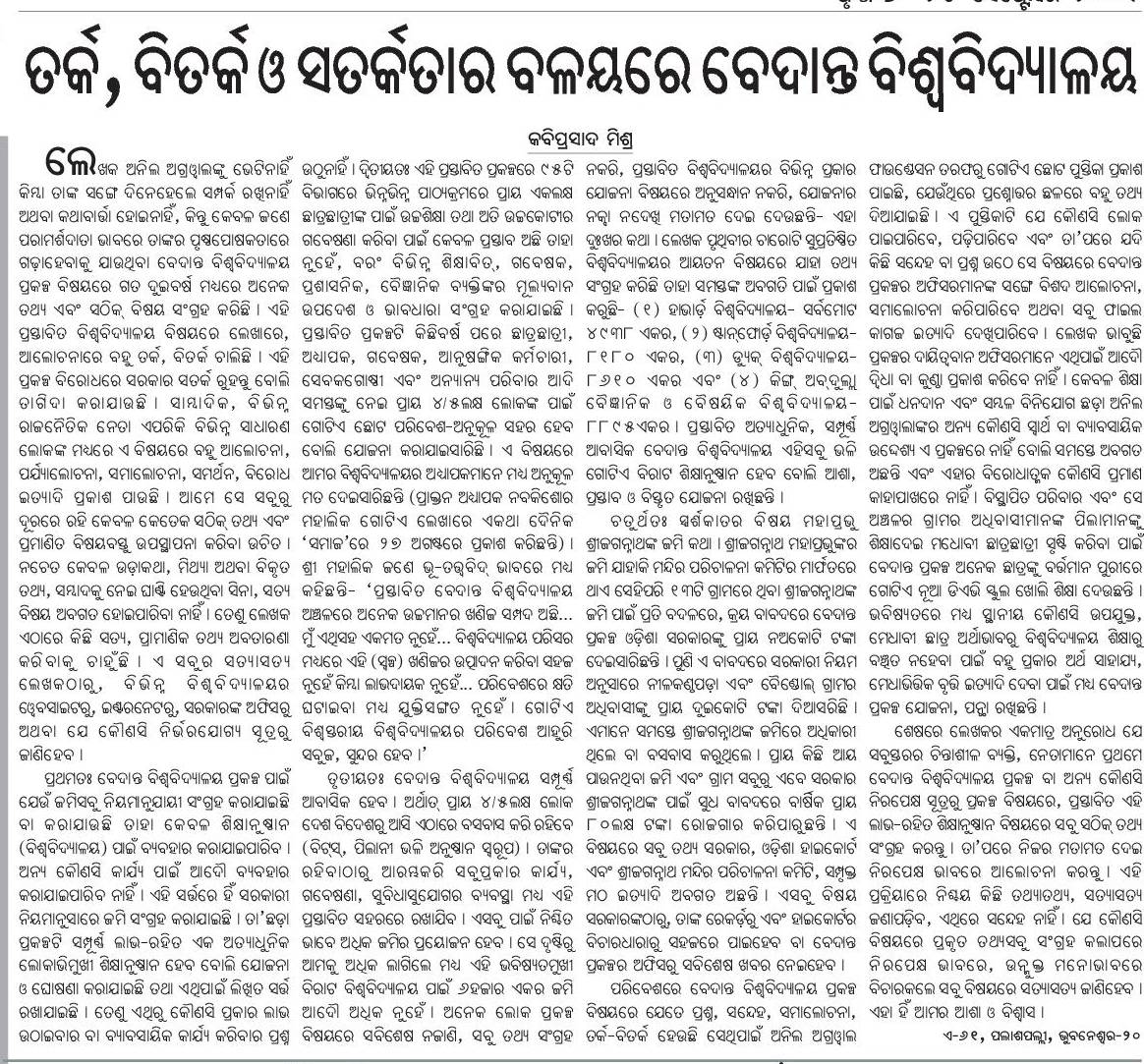
Given below is the article by retired Utkal University Professor Nabakishore Mahalik on August 27th that the above writer mentions.
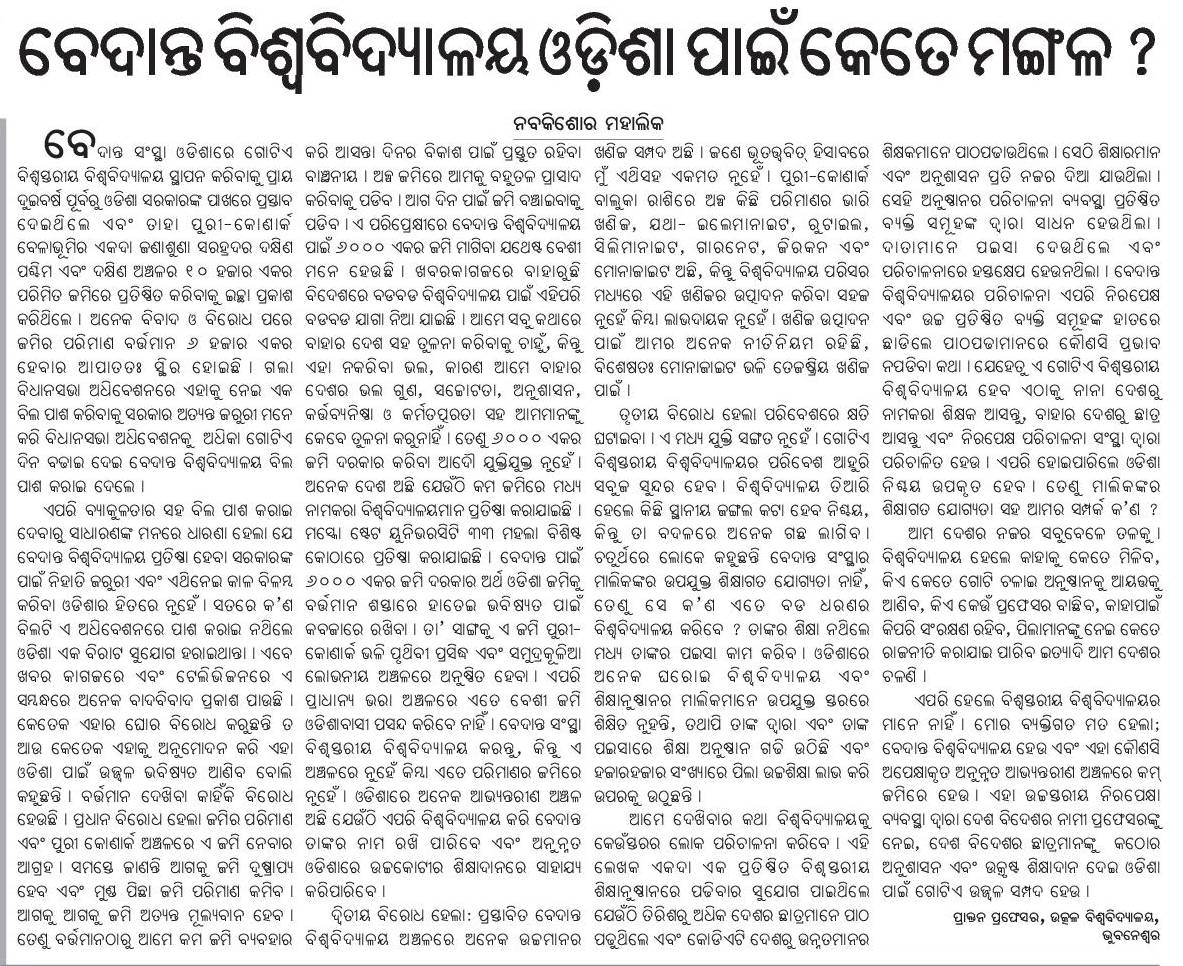
September 24th, 2009
The documents are at:
* http://www.education.nic.in/uhe/Universitiesconceptnote.pdf
* http://www.education.nic.in/uhe/Concept-BGP.pdf
Following are some excerpts from the first document:
Continue Reading September 22nd, 2009
Next Posts
Previous Posts
.jpg)







